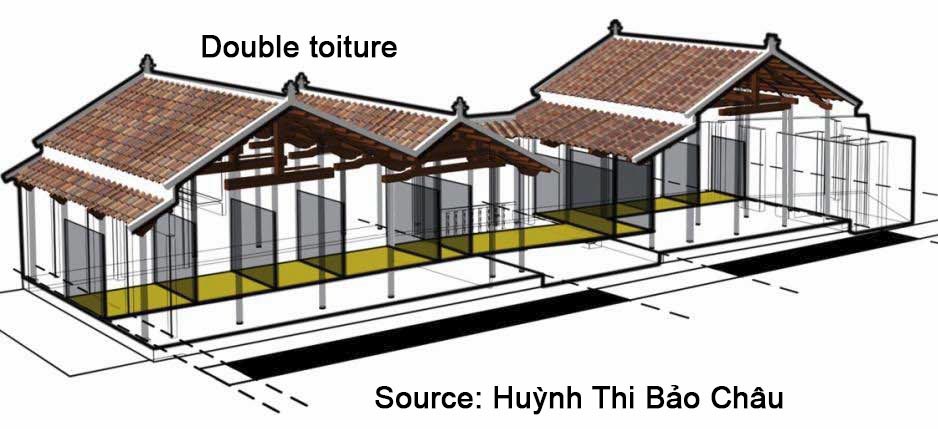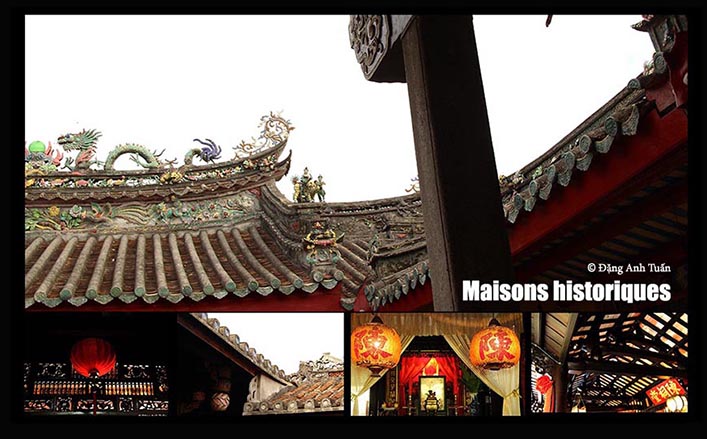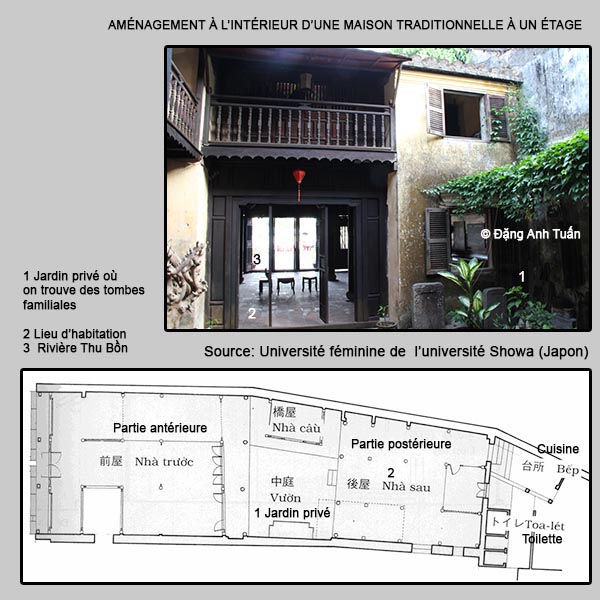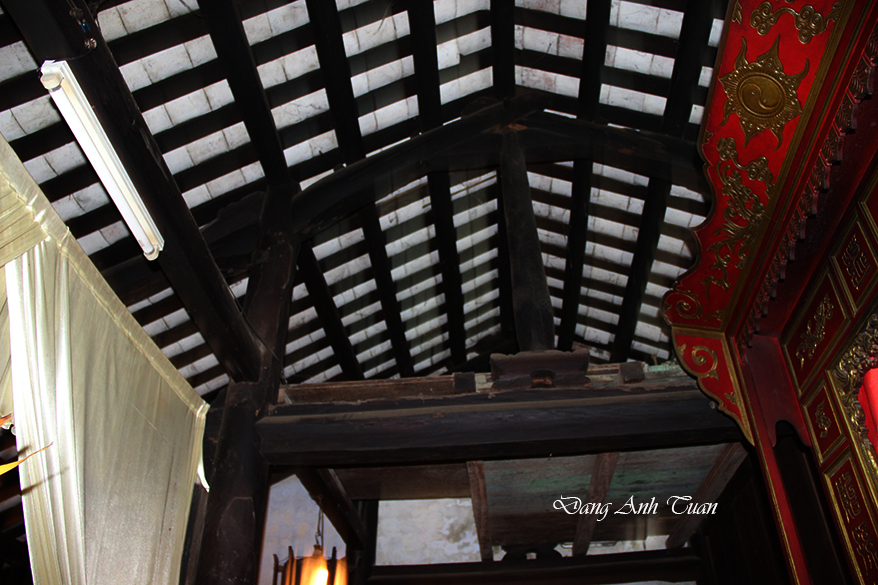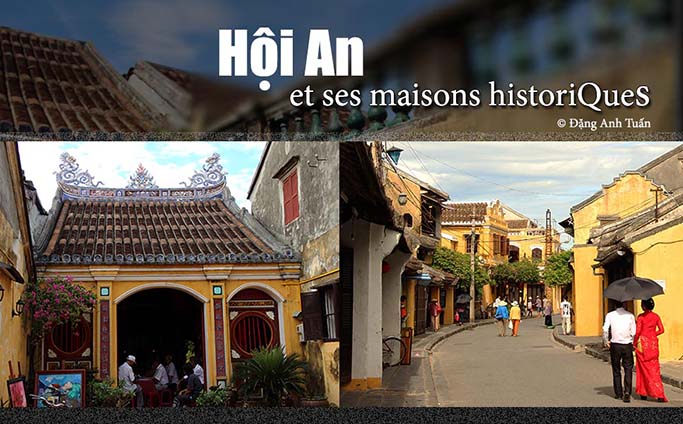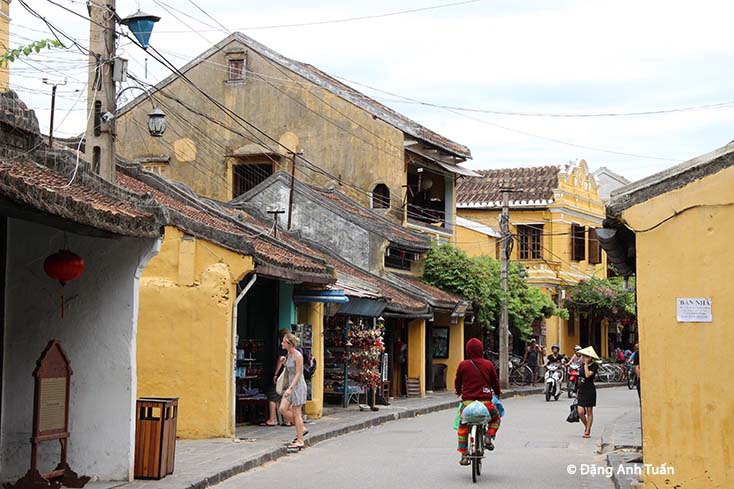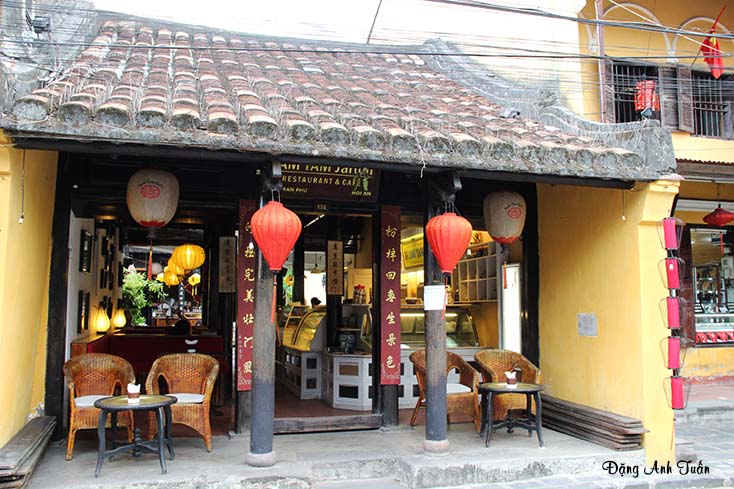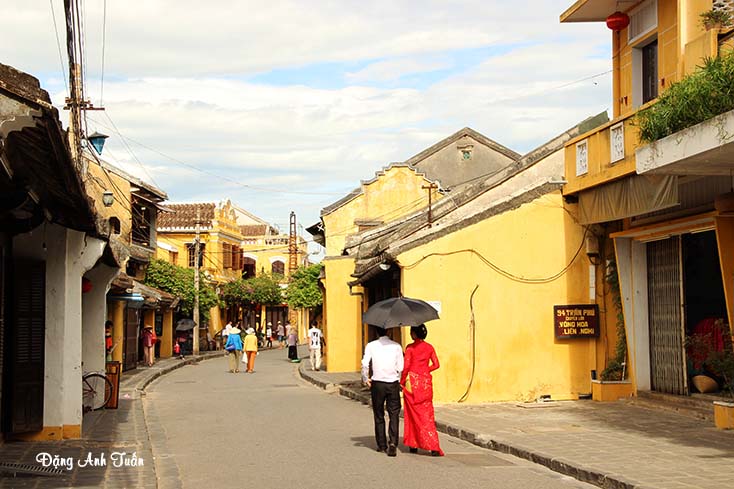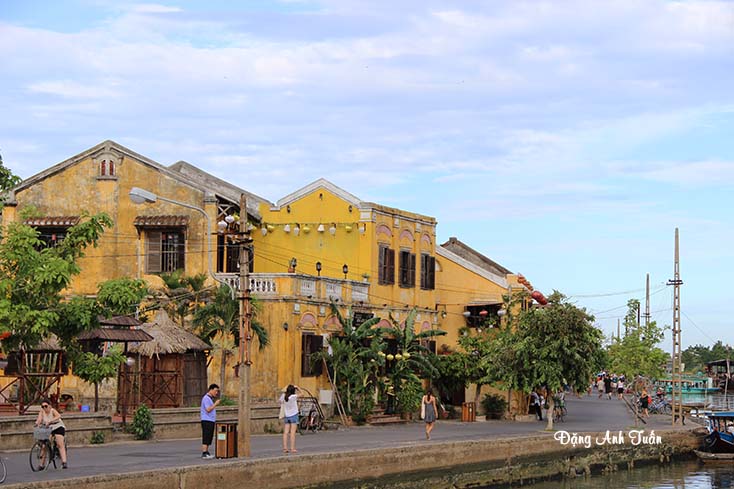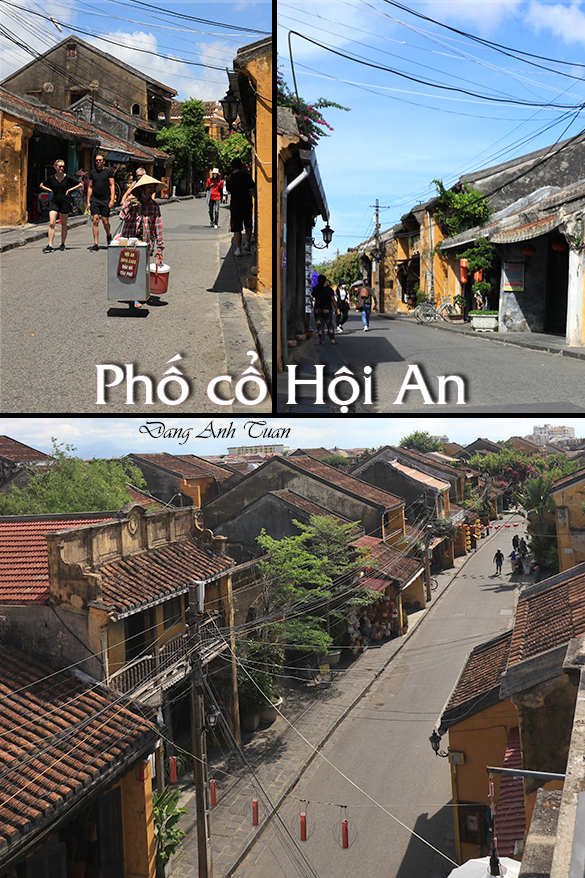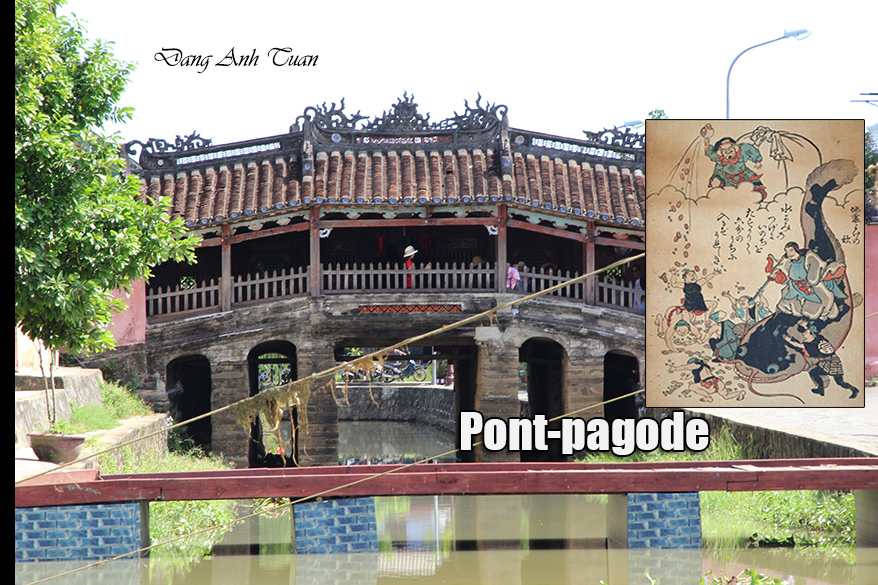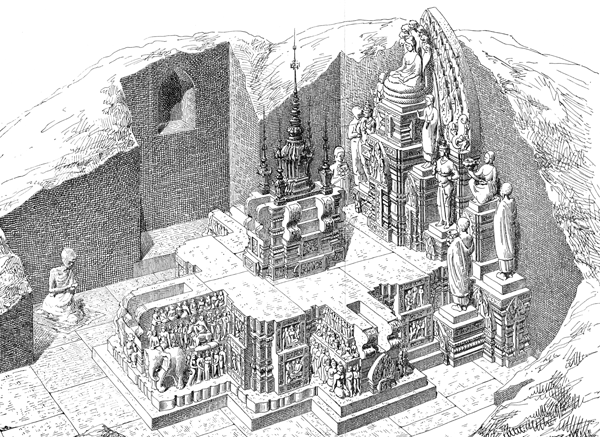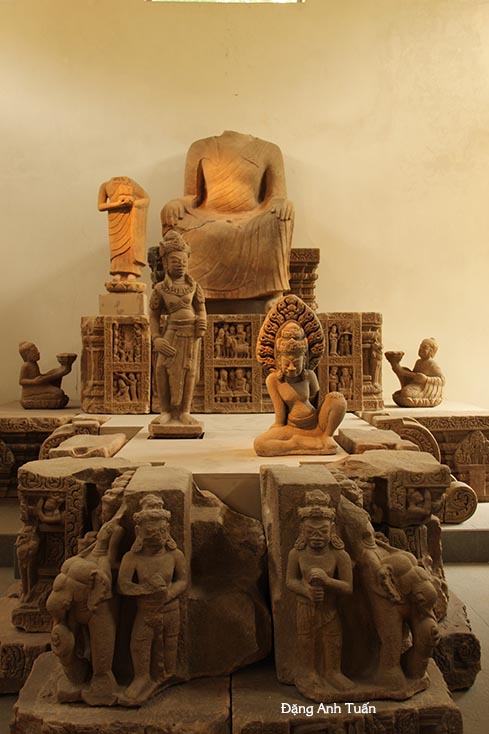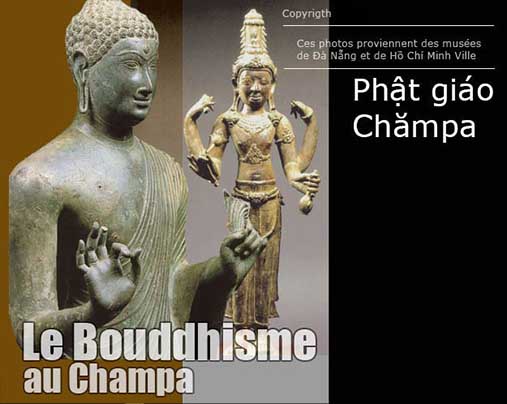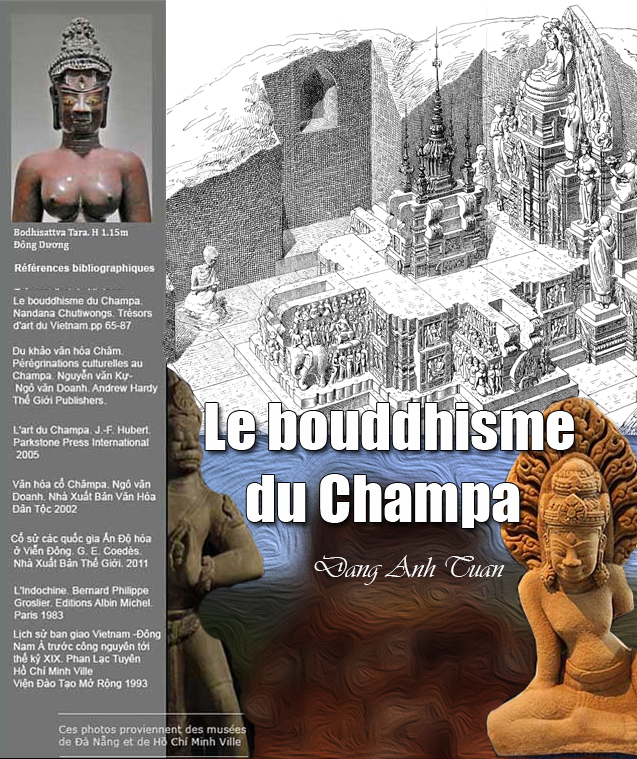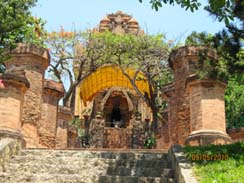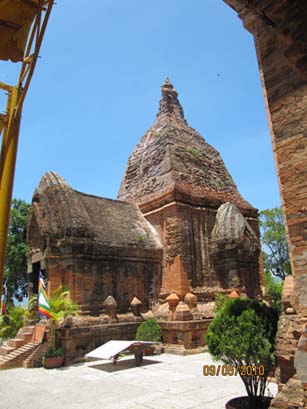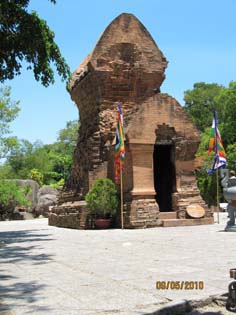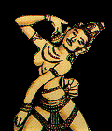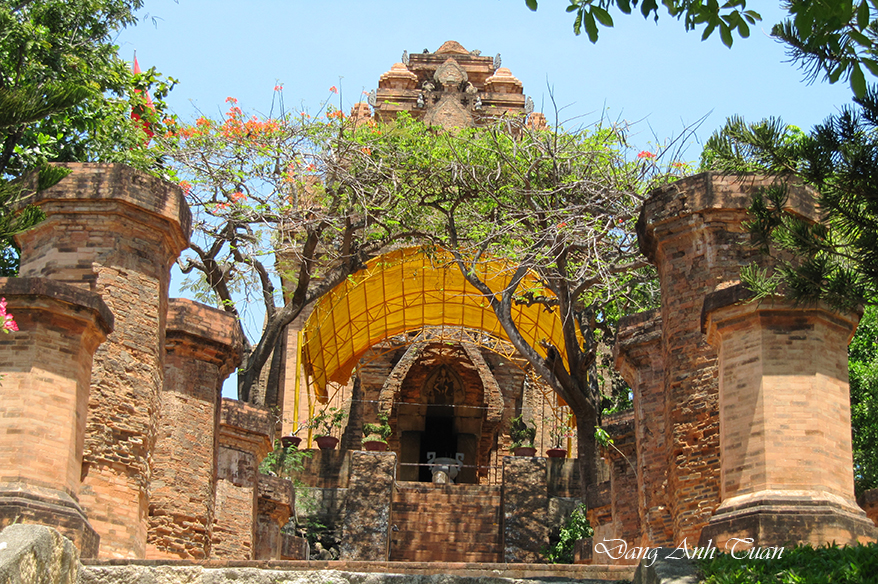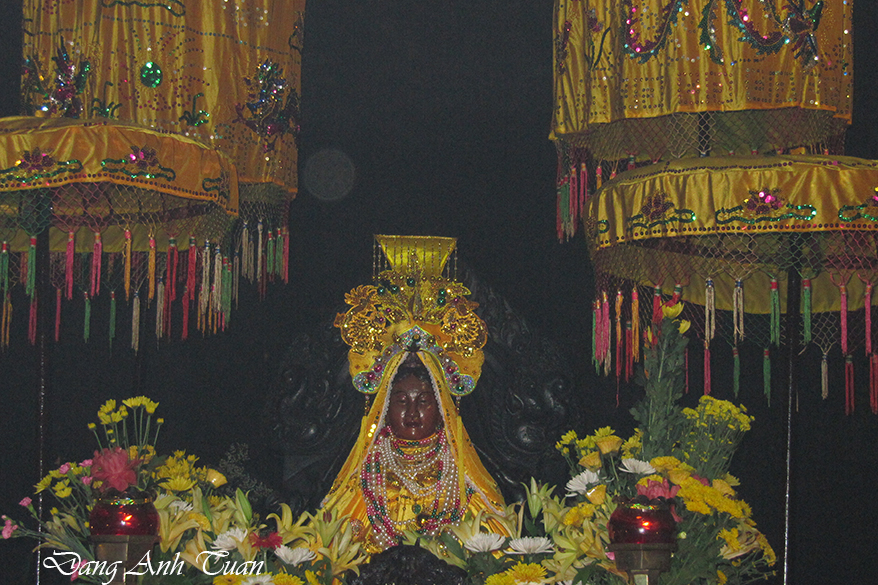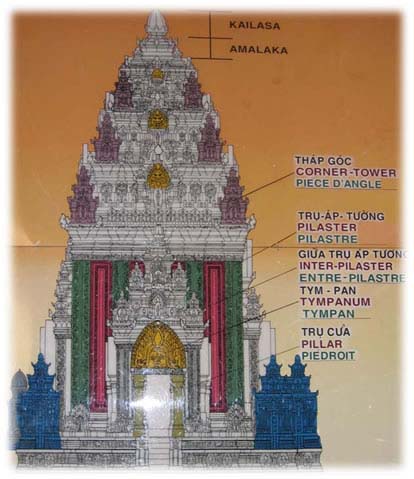Schéma de la double toiture d’une maison traditionnelle
Nét duyên dáng của nhà cổ
Une autre caractéristique importante de la maison traditionnelle de Hội An est la présence d’une paire de « yeux du dragon » en bois accrochés souvent au dessus de sa porte d’entrée. Parfois on les retrouve à l’intérieur de la maison. On recense au moins une vingtaine de modèles ayant chacun une forme différente: un rond, un octogone etc. mais le plus commun trouvé reste le chrysanthème à huit pétales correspondant aux 8 caractères trouvés dans le Yi King (Kinh Dịch) et ayant à son centre le symbole du Yin et du Yang (Âm Dương). Ces yeux du dragon sont aussi un détail important que l’architecte polonais Kazimierz Kwiatkowsky (Kazik) n’a pas laissé s’échapper au moment où il avait l’occasion d’examiner l’architecture de Hội An, en particulier celle de ses maisons traditionnelles. Certains spécialistes trouvent dans ces yeux l’incarnation de l’âme de la ville Hội An tandis que d’autres attribuent à cette paire l’allégorie de la culture et de la tradition orientale. Selon l’écrivain Hữu Ngọc, les chercheurs ont trouvé leur origine à partir des clous en bois dont on est habitué à voir la fixation dans les linteaux des portes d’accès aux temples bouddhistes dans le Sud de la Chine. Personne ne conteste cette explication relative à leur origine mais on est amené à penser que cette paire d’yeux revêt plutôt une signification très spéciale, un caractère spirituel ou religieux que le propriétaire aimerait lier à son destin lors de son installation. Pour ce dernier, ces yeux ont la faculté d’entendre les réflexions de chaque membre au sein de la famille et de capter aussi tout ce qui s’est passé autour de la maison et au coeur même de sa propre vie. Il faut se rappeler qu’avant d’être sinisés, les gens de la région du Sud de la Chine faisaient partie du groupe Bai Yue (Cent Yue). Analogues aux Vietnamiens, ils étaient animistes car ils croyaient qu’il existe une force vitale, une âme animant tous les êtres naturels ou non (y compris les objets). (Vạn vật hữu linh). Ce culte perdura depuis la nuit des temps. Ces yeux du dragon sont en quelque sorte ceux du génie protecteur de la maison.
Une autre particularité retient l’attention de ceux qui ont l’occasion de visiter les maisons anciennes de Hội An. Ce sont les tuiles tubulaires yin yang (ngói ống âm dương) qu’on est habitué à trouver souvent dans les bâtiments imposants des grandes surfaces commerciales en Asie. Ces tuiles ayant la forme d’un quart de cylindre, sont disposées de manière qu’une tuile convexe est reliée à une tuile concave, ce qui leur permet de recevoir le nom de « tuiles yin-yang » grâce à l’équilibre trouvé dans le Yin et le Yang.. Elles sont en terre cuite et sont divisées toujours en quatre pièces courbes, avant d’être déposées dans une moule cylindrique et soumises au séchage et au cuisson.
Quant aux maisons traditionnelles « nhà rường« , elles sont plus spacieuses et plus confortables car elles peuvent comporter de 3 jusqu’à 5 bâtiments. Ells ont souvent à l’arrière du premier bâtiment, un jardin privé en miniature où le propriétaire, en temps de repos et de loisir, vient fumer du tabac, prendre du thé avec ses amis et contempler le paysage. Il vous manque seulement la visite pour apprécier les attributs distinctifs des maisons traditionnelles de Hội An et leurs valeurs du passé. [Return HOI AN]
Another important feature of the traditional Hội An house is the presence of a pair of wooden « dragon eyes » often hung above its entrance door. Sometimes they are found inside the house. At least twenty models have been recorded, each with a different shape: a circle, an octagon, etc., but the most common one found remains the chrysanthemum with eight petals corresponding to the 8 characters found in the Yi King (Kinh Dịch) and having at its center the symbol of Yin and Yang (Âm Dương). These dragon eyes are also an important detail that the Polish architect Kazimierz Kwiatkowsky (Kazik) did not overlook when he had the opportunity to examine the architecture of Hội An, particularly that of its traditional houses. Some specialists see in these eyes the embodiment of the soul of the city of Hội An, while others attribute to this pair the allegory of Eastern culture and tradition. According to the writer Hữu Ngọc, researchers have traced their origin to wooden nails commonly seen fixing the lintels of entrance doors to Buddhist temples in southern China. No one disputes this explanation regarding their origin, but one is led to think that this pair of eyes rather carries a very special meaning, a spiritual or religious character that the owner would like to link to their destiny upon settling in.
For the latter, these eyes have the ability to hear the thoughts of each family member and also to capture everything that has happened around the house and at the very heart of their own life. It should be remembered that before being sinicized, the people of the southern region of China were part of the Bai Yue group (Hundred Yue). Similar to the Vietnamese, they were animists because they believed in a vital force, a soul animating all natural or non-natural beings (including objects). (Vạn vật hữu linh). This cult has lasted since time immemorial. These dragon eyes are in a way those of the protective spirit of the house.
Another particularity catches the attention of those who have the opportunity to visit the old houses of Hội An. These are the yin yang tubular tiles (ngói ống âm dương) often found in the imposing buildings of large commercial areas in Asia. These tiles, shaped like a quarter of a cylinder, are arranged so that a convex tile is connected to a concave tile, which allows them to be called « yin-yang tiles » thanks to the balance found in Yin and Yang. They are made of terracotta and are always divided into four curved pieces before being placed in a cylindrical mold and subjected to drying and firing.
As for the traditional « nhà rường » houses, they are more spacious and comfortable because they can consist of 3 to 5 buildings. They often have, at the back of the first building, a miniature private garden where the owner, during rest and leisure time, comes to smoke tobacco, have tea with friends, and contemplate the landscape. All that is missing is your visit to appreciate the distinctive attributes of Hội An’s traditional houses and their values from the past.
Một đặc điểm quan trọng khác của ngôi nhà truyền thống Hội An là sự hiện diện của một cặp « mắt rồng » bằng gỗ thường được treo phía trên cửa ra vào. Đôi khi chúng được tìm thấy bên trong ngôi nhà. Ít nhất hai mươi mô hình đã được ghi nhận, mỗi mô hình có một hình dạng khác nhau: hình tròn, hình bát giác vân vân nhưng mô hình phổ biến nhất được tìm thấy vẫn là hoa cúc với tám cánh hoa tương ứng với 8 ký tự được tìm thấy trong Kinh Dịch và có biểu tượng Âm Dương ở trung tâm. Những đôi mắt rồng này cũng là một chi tiết quan trọng mà kiến trúc sư người Ba Lan Kazimierz Kwiatkowsky (Kazik) không bỏ qua khi ông có cơ hội nghiên cứu kiến trúc của Hội An, đặc biệt là kiến trúc của những ngôi nhà truyền thống. Một số chuyên gia nhìn thấy ở đôi mắt này sự hiện thân của linh hồn thành phố Hội An, trong khi những người khác lại cho rằng cặp mắt này là ẩn dụ về văn hóa và truyền thống phương Đông.
Theo nhà văn Hữu Ngọc, các nhà nghiên cứu đã lần ra nguồn gốc của chúng từ những chiếc đinh gỗ thường thấy trên các thanh ngang cửa ra vào của các ngôi chùa Phật giáo ở miền Nam Trung Quốc. Không ai tranh cãi về lời giải thích này về nguồn gốc của chúng, nhưng người ta cho rằng đôi mắt rồng này mang một ý nghĩa rất đặc biệt, một đặc điểm tâm linh hoặc tôn giáo mà chủ nhân muốn gắn kết với vận mệnh của mình khi định cư. Đối với người theo chủ nghĩa này, đôi mắt rồng có khả năng nghe được suy nghĩ của từng thành viên trong gia đình và cũng có thể nắm bắt mọi thứ đã xảy ra xung quanh ngôi nhà và ngay trong chính cuộc sống của họ. Cần nhớ rằng trước khi bị Hán hóa, người dân miền Nam Trung Quốc thuộc nhóm Bách Việt (Bách Việt).
Tương tự như người Việt Nam, họ theo thuyết vật linh vì họ tin vào một sức sống, một linh hồn điều khiển mọi sinh vật tự nhiên hoặc phi tự nhiên (bao gồm cả đồ vật). Tín ngưỡng này đã tồn tại từ xa xưa. Đôi mắt rồng, theo một cách nào đó, là linh hồn bảo vệ ngôi nhà.Một điểm đặc biệt khác thu hút sự chú ý của những ai có dịp ghé thăm những ngôi nhà cổ Hội An. Đó là những viên ngói ống âm dương thường thấy trong các tòa nhà đồ sộ của các khu thương mại lớn ở châu Á. Những viên ngói này, có hình dạng như một phần tư hình trụ, được sắp xếp sao cho một viên lồi nối với một viên lõm, nhờ vào sự cân bằng giữa Âm và Dương mà chúng được gọi là « ngói ống âm dương » (gạch âm dương). Chúng được làm bằng đất nung và luôn được chia thành bốn phần cong trước khi được đặt vào khuôn hình trụ, sấy khô và nung. Đối với những ngôi nhà rường truyền thống, chúng rộng rãi và thoải mái hơn vì có thể bao gồm 3 đến 5 tòa nhà. Chúng thường có một khu vườn riêng thu nhỏ ở phía sau tòa nhà đầu tiên, nơi chủ nhà, trong thời gian nghỉ ngơi và giải trí, đến hút thuốc lá, uống trà với bạn bè và ngắm cảnh. Điều duy nhất còn thiếu là chuyến thăm của bạn để cảm nhận những nét đặc trưng của những ngôi nhà truyền thống Hội An và những giá trị của chúng từ quá khứ.

